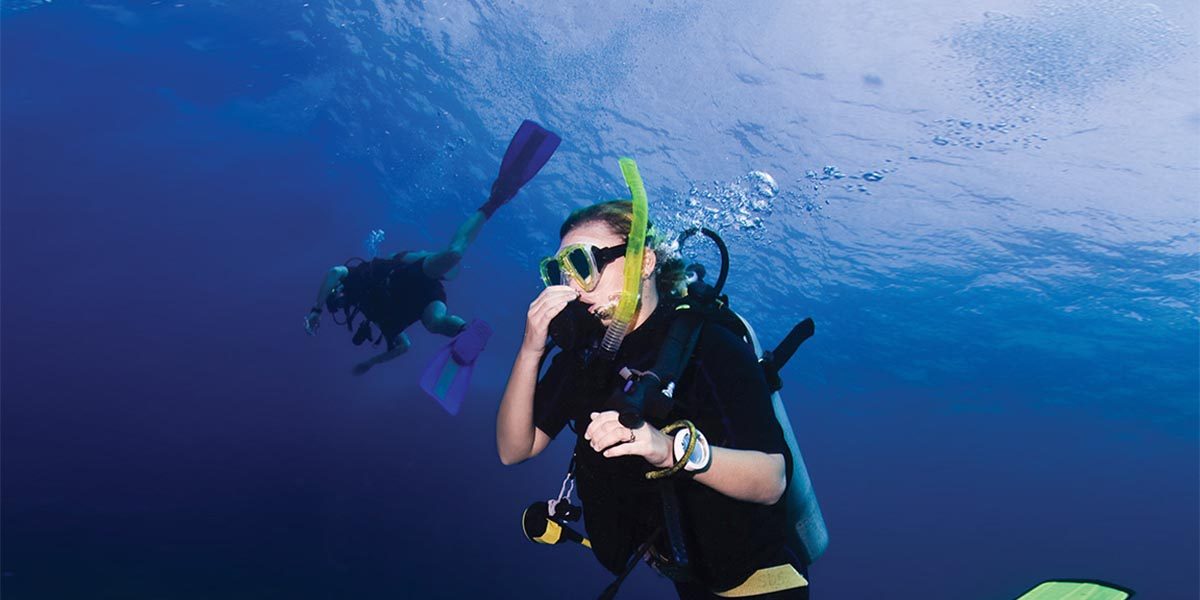All methods for equalizing your ears are simply ways to open the lower ends of your Eustachian tubes, so air can enter.
VALSALVA MANEUVER | Pinch Your Nose and Blow
This is the method most divers learn: Pinch your nostrils (or close them against your mask skirt) and blow through your nose. The resulting overpressure in your throat usually forces air up your Eustachian tubes.
But the Valsalva maneuver has three problems:
- It does not activate muscles which open the Eustachian tubes, so it may not work if the tubes are already locked by a pressure differential.
- It’s too easy to blow hard enough to damage something.
- Blowing against a blocked nose raises your internal fluid pressure, including the fluid pressure in your inner ear, which may rupture your “round windows.” So don’t blow too hard, and don’t maintain pressure for more than five seconds.
Swallowing—and various methods of equalizing—are all ways of opening the normally closed Eustachian tubes, reducing the pressure differential between the outer ear and inner ear. The safest clearing methods utilize the muscles of the throat to open the tubes. Unfortunately, the Valsalva maneuver that most divers are taught does not activate these muscles, but forces air from the throat into the Eustachian tubes.
That’s fine as long as the diver keeps the tubes open ahead of the exterior pressure changes. However, if a diver does not equalize early or often enough, the pressure differential can force the soft tissues together, closing the ends of the tubes. Forcing air against these soft tissues just locks them shut. No air gets to the middle ears, which do not equalize, so barotrauma results. Even worse, blowing too hard during a Valsalva maneuver can rupture the round and oval windows of the inner ear.
Other Methods, Some Safer, Include:
PASSIVE | Requires No Effort
Typically occurs during ascent.
VOLUNTARY TUBAL OPENING | Tense Your Throat and Push Your Jaw Forward
Tense the muscles of the soft palate and the throat while pushing the jaw forward and down as if starting to yawn. These muscles pull the Eustachian tubes open. This requires a lot of practice, but some divers can learn to control those muscles and hold their tubes open for continuous equalization.
TOYNBEE MANEUVER | Pinch Your Nose and Swallow
With your nostrils pinched or blocked against your mask skirt, swallow. Swallowing pulls open your Eustachian tubes while the movement of your tongue, with your nose closed, compresses air against them.
FRENZEL MANEUVER | Pinch Your Nose and Make the Sound of the Letter “K”
Close your nostrils, and close the back of your throat as if straining to lift a weight. Then make the sound of the letter “K.” This forces the back of your tongue upward, compressing air against the openings of your Eustachian tubes.
LOWRY TECHNIQUE | Pinch Your Nose, Blow and Swallow
A combination of Valsalva and Toynbee: while closing your nostrils, blow and swallow at the same time.
EDMONDS TECHNIQUE | Pinch Your Nose and Blow and Push Your Jaw Forward
While tensing the soft palate (the soft tissue at the back of the roof of your mouth) and throat muscles and pushing the jaw forward and down, do a Valsalva maneuver.
Practice Makes Perfect
Divers who experience difficulty equalizing may find it helpful to master several techniques. Many are difficult until practiced repeatedly, but this is one scuba skill you can practice anywhere. Try practicing in front of a mirror so you can watch your throat muscles.
When to Equalize
Sooner, and more often, than you might think. Most authorities recommend equalizing every two feet of descent. At a fairly slow descent rate of 60 feet per minute, that’s an equalization every two seconds. Many divers descend much faster and should be equalizing constantly.
The good news: as you go deeper, you’ll have to equalize less often—another result of Boyle’s Law. For example, a descent of six feet from the surface will compress your middle ear space by 20% and produce pain. But from 30 feet you’d have to descend another 12.5 feet to get the same 20% compression.
When you reach your maximum depth, equalize again. Though the negative pressure in your middle ear may be so small that you don’t feel it, if it’s maintained over several minutes it can gradually cause barotrauma.


